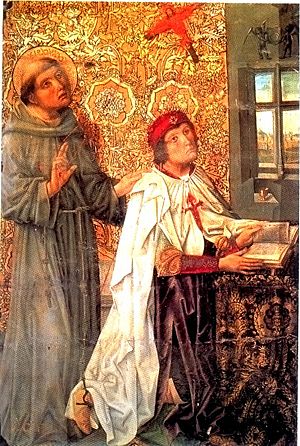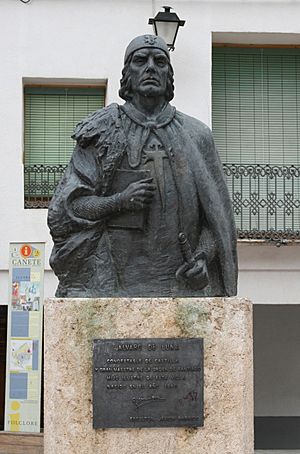Álvaro de Luna facts for kids
Quick facts for kids
Álvaro de Luna
|
|
|---|---|

Álvaro de Luna dressed in the habit of the Order of Santiago
|
|
| Constable of Castile | |
| In office 1423–1453 |
|
| Preceded by | Ruy López Dávalos |
| Succeeded by | Miguel Lucas de Iranzo |
| Personal details | |
| Born | Cañete, Crown of Castile |
| Died | 2 June 1453 Valladolid, Crown of Castile |
| Spouses |
Elvira de Portocarrero
(m. 1420)Juana Pimentel
(m. 1430) |
Álvaro de Luna y Fernández de Jarava (born around 1388 to 1390 – died 2 June 1453) was a very important person in the history of Castile, a kingdom in what is now Spain. He was a trusted friend and advisor to John II of Castile, the king. Álvaro de Luna held powerful jobs like Constable of Castile (a top military leader) and Grand Master of the Order of Santiago (a knightly order). He gained a lot of power by supporting King John II against a group of nobles called the Infantes of Aragon. However, he eventually lost the king's trust and was put to death in Valladolid in 1453.
Who was Álvaro de Luna?
Álvaro de Luna was born in Cañete, a town in what is now the province of Cuenca. He was born around 1388 to 1390. His father was a nobleman named Álvaro Martínez de Luna, who was the king's cup-bearer (the person who served drinks to the king). His mother was María Fernández de Jarana.
Álvaro de Luna came to the royal court as a young page (a servant to a nobleman) in 1410. His uncle, Pedro V de Luna, who was the Archbishop of Toledo, helped him get this job. Álvaro quickly became very close to the young King John II, who was just a boy at the time.
When King John's uncle, Ferdinand, was in charge of the kingdom (this is called a regency), Álvaro was just a servant. But after Ferdinand became king of Aragon, King John's mother, Catherine of Lancaster, took over the regency. At this point, Álvaro became a very important person. He was known as the "contino", which meant he was a very close and trusted friend of the King.
Álvaro de Luna married Elvira de Portocarrero in 1420, but they did not have any children. Later, in 1430, he married Juana Pimentel. They had two children together.
A King's Best Friend

The young King John II really loved and trusted Álvaro de Luna. Some people at the time even thought it was due to magic because of how much influence Álvaro had! The King was often pressured by powerful nobles who wanted more power for themselves. These nobles included his cousins, the sons of Ferdinand, known as the Infantes of Aragon. They were very dangerous and pretended they wanted to free the King from Álvaro's influence, but they really just wanted to control the King themselves.
Because of this, it made sense that the King relied so much on Álvaro. Álvaro had every reason to be loyal to the King. Álvaro was also very good at things the King admired. He was an excellent horseman, skilled with a lance (a type of spear), and even wrote poetry for the court. He was also very clever at making plans and keeping his true intentions hidden.
For a long time, Álvaro de Luna was the most important person in Castile. This was a time of constant fighting. Different groups of nobles kept forming alliances and then changing sides. Álvaro de Luna was always at the center of these conflicts.
Historians have different ideas about Álvaro de Luna. Some, like Juan de Mariana, thought he only cared about himself and his own power. Others believed he was a loyal servant to the King. They thought he tried to make the King's power stronger, which was the only way to stop the kingdom from falling into chaos and fighting. Even if he fought for his own goals, his strong leadership might have been better than having many nobles who just wanted to raid and steal.
In 1427, a group of nobles managed to get Álvaro de Luna sent away from the court. But he was called back the very next year. In 1431, he tried to get the restless nobles to fight in a campaign to take back Granada, the last part of Muslim Spain, from the sultan Muhammed IX. They had some success at the Battle of La Higueruela, but Álvaro de Luna's plan didn't fully work in the end. It was very hard to have a clear plan when the nobles were always rebelling and the King was not very active.
In 1445, the group of nobles who were allied with Álvaro's main enemies, the Infantes of Aragon, were defeated at the First Battle of Olmedo. One of them, Infante Henry, who was the Queen's brother, died from his injuries. Álvaro de Luna had been the Constable of Castile and Count of San Esteban de Gormaz since 1423. After this victory, he also became the Grand Master of the Order of Santiago because the Knights chose him.
Losing Power
King John's first wife, Queen Maria, died under unclear circumstances. Some people suspected Álvaro de Luna was involved. Even so, his power seemed very strong. But his power really depended only on the King's personal affection for him.
The King's second wife, Isabella of Portugal, was not happy with how much influence Álvaro had. Even though Álvaro had arranged her marriage to the King, she felt he had too much control. When the King's accountant, Alfonso Pérez de Vivero, was killed, and people suspected Álvaro de Luna had ordered it, Queen Isabella urged her husband to get rid of his favorite.
In 1453, the King finally gave in to his wife's demands. Álvaro de Luna was arrested, put on trial, and sentenced to death. He was put to death by beheading in Valladolid on 2 June 1453.
Family Life
Álvaro de Luna and his second wife, Juana Pimentel, had two children:
- Juan de Luna y Pimentel: He married Leonor de Zuniga y Lara.
- María de Luna y Pimentel: She became the main heir after her brother died young. She married Íñigo López de Mendoza y Luna, 2nd Duke of the Infantado.
Álvaro de Luna also had a son named Pedro de Luna y Manuel with Margarita Manuel. This son was later officially recognized as his child.
See also
 In Spanish: Álvaro de Luna para niños
In Spanish: Álvaro de Luna para niños
- Castilian Civil War of 1437–1445

